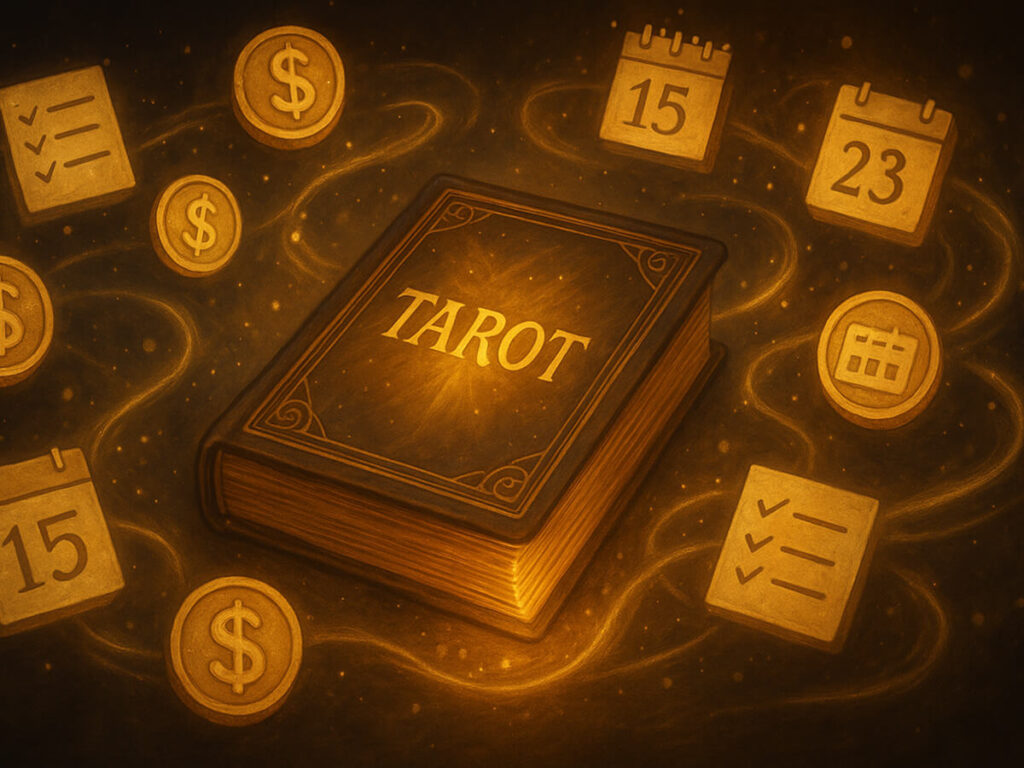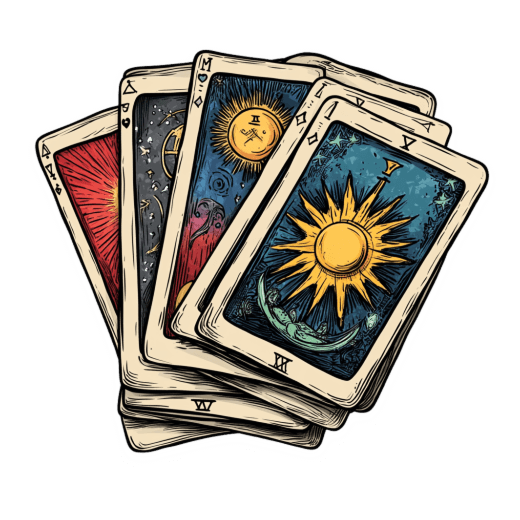How to Use Tarot to Set & Plan for Financial Goals


Table of Contents
Did you know that 63% of Americans live paycheck to paycheck according to a recent financial wellness survey? I certainly understand that financial anxiety. I’ve been there myself. When I first discovered tarot as a tool for financial planning twenty years ago, I was skeptical. How could a deck of cards possibly help with something as practical as money management?
Yet here I am, decades later, having witnessed firsthand how tarot can illuminate our relationship with money in ways traditional financial planning often misses. As someone who’s spent over four decades studying both tarot symbolism and financial principles, I’ve developed a unique perspective on blending these seemingly disparate worlds.
Tarot isn’t about predicting lottery numbers or guaranteeing investment returns. Rather, it’s about accessing your intuition and subconscious knowledge about money. It reveals the emotional patterns and blind spots that even the best financial advisor might not uncover. When used alongside conventional financial planning, tarot becomes a powerful tool for holistic money management.
In my practice, I’ve guided thousands of clients to financial clarity using these ancient symbols. The cards often reveal what we already know deep down but haven’t consciously acknowledged. They can highlight our financial strengths, warn of potential pitfalls, and suggest creative solutions to money challenges that we might not have considered.
This guide explores practical ways to incorporate tarot into your financial planning process for 2025 and beyond. Whether you’re a tarot enthusiast curious about financial applications or a pragmatic planner open to intuitive methods, you’ll find actionable techniques to enhance your money journey. The wisdom of tarot isn’t about abandoning rational financial strategies. It’s about enriching them with deeper personal insights.
Let me share what I’ve learned about this fascinating intersection of the mystical and the practical, and how it might transform your relationship with money in surprisingly practical ways.
Understanding the Connection Between Tarot and Financial Guidance
The relationship between tarot and financial guidance goes back centuries, though many don’t realize it. In my early days as a financial advisor (before I integrated tarot into my practice), I was frustrated by how often solid financial plans failed. The numbers made sense, but clients still struggled. Something was missing.
That missing piece? The psychological and emotional dimensions of money. I discovered this accidentally when a client brought her tarot deck to a session in 1997. As she explained the symbolism of the Pentacles cards, I had an epiphany. These ancient images captured financial archetypes and patterns that my spreadsheets couldn’t.
Tarot works as a financial tool because money decisions are rarely just about numbers. Research from behavioral economics confirms what tarot readers have known for centuries. We’re emotional beings when it comes to finances. A 2019 study in the Journal of Economic Psychology found that financial decisions are influenced by unconscious biases and emotional patterns. This is exactly what tarot excels at illuminating.
“The symbolism in tarot provides a mirror reflecting our unconscious relationship with money,” explains Dr. Marta Silvestri, financial psychologist and tarot practitioner. “When we see our financial behaviors represented in the cards, we gain perspective that rational analysis alone cannot provide.”
I’ve seen this countless times in my practice. One client, a successful executive, kept pulling the Five of Pentacles during sessions. This card is often associated with financial insecurity. Despite her substantial savings, she operated from a scarcity mindset that drove compulsive working habits. The card helped her recognize this pattern when years of traditional financial advice couldn’t.
It’s important to understand what tarot for financial planning isn’t. It’s not fortune telling or a replacement for sound financial principles. I always remind my clients that tarot won’t tell you which stocks will perform best next quarter. Rather, it complements conventional planning by:
- Revealing unconscious money beliefs that impact financial behavior
- Providing a symbolic framework for processing complex financial emotions
- Offering perspective on financial crossroads when the “right” choice isn’t clear
- Helping identify patterns of financial self sabotage
When used thoughtfully, tarot creates a bridge between your rational financial knowledge and your intuitive understanding. This integration leads to more aligned money decisions and, in my experience, greater financial peace of mind.
Essential Tarot Cards That Reveal Financial Insights
In my twenty five years of financial tarot work, I’ve found certain cards consistently provide profound money insights. The Pentacles (or Coins) suit naturally dominates financial readings, but cards throughout the deck offer valuable perspectives on your money journey.
The Pentacles suit directly addresses material concerns. Each card reveals different aspects of financial experience:
The Ace of Pentacles often appears when new financial opportunities emerge. I remember pulling this card just before discovering an investment that eventually funded my daughter’s college education. It doesn’t guarantee wealth, but signals potential for material growth when you remain alert to possibilities.
The Ten of Pentacles represents long term wealth and financial legacy. This card frequently appears for clients considering estate planning or multigenerational wealth concerns. Conversely, the Five of Pentacles suggests financial insecurity or feeling “left out in the cold” financially. It warns us to examine scarcity mindsets even amid objective abundance.
Beyond Pentacles, several Major Arcana cards provide crucial financial insights. The Emperor represents financial structure and authority. It appears often when questions involve budgeting systems or financial discipline. The Hierophant suggests conventional financial wisdom, while The Fool might indicate a need for fresh financial thinking, perhaps questioning outdated money beliefs.
The Magician deserves special attention in financial readings. This card speaks to resourcefulness and the ability to manifest prosperity through focused intention. I’ve had clients turn around dire financial situations after working with Magician energy. Not through magical thinking, but by recognizing previously untapped resources and capabilities.
Court Cards often represent financial personalities or approaches to money. The King of Pentacles embodies mastery of the material realm. He’s financially savvy and grounded. The Knight of Wands might suggest entrepreneurial energy but possibly impulsive financial decisions.
I made a costly mistake early in my career by ignoring the Tower card in a personal financial reading. Three months later, an unexpected tax liability disrupted my carefully planned budget. Now I pay careful attention to cards suggesting potential financial disruption:
- The Tower warns of sudden financial changes requiring adaptation
- The Moon reveals hidden financial fears or unclear money situations
- The Devil highlights unhealthy financial attachments or limiting beliefs
Understanding these cards’ financial dimensions requires practice and personalization. The same card might suggest different actions for different individuals based on their unique circumstances. I always encourage my clients to develop their own financial interpretations rather than relying solely on traditional meanings.
Powerful Tarot Spreads Designed for Money Questions
Over decades of financial tarot work, I’ve developed several spreads specifically tailored for money matters. The right spread can transform a vague money concern into actionable financial insight. While many practitioners rely on generic spreads, financial questions benefit from specialized layouts.
For immediate financial decisions, I recommend a simple but powerful 3 card spread:
- Current financial situation
- Challenge or opportunity to consider
- Potential outcome if current course continues
This straightforward approach provides remarkable clarity. I used this spread with a client facing a job change opportunity. The Eight of Pentacles (skilled work) appeared in position one, suggesting her current expertise was valuable. The Chariot reversed in position two revealed her hesitation about moving forward. The final card, the Six of Wands, indicated potential recognition if she overcame her reluctance. She took the position and later received an industry award for her work.
For comprehensive financial planning, I’ve found a 7 card spread most effective:
- Current financial mindset
- Unconscious financial beliefs
- Financial strengths to leverage
- Challenges to address
- External factors affecting finances
- Action guidance
- Potential outcome with conscious action
This spread helps integrate intuitive insights with practical planning. It typically reveals patterns clients haven’t recognized. A memorable session involved a successful consultant who couldn’t understand her persistent money struggles despite high income. Her spread revealed the Two of Swords (avoidance) in the unconscious position. She was literally refusing to look at her financial statements! This simple awareness transformed her relationship with money.
For career and income questions, try this specialized 5 card spread:
- Current career energy
- Hidden potential or talent
- Obstacle to income growth
- Action to expand prosperity
- Long term career direction
When formulating questions for financial readings, specificity matters. Vague questions (“Will I be rich?”) yield vague answers. I suggest questions like:
- “What should I understand about my spending patterns?”
- “What unconscious beliefs might be limiting my income?”
- “How might I approach this investment decision more wisely?”
I’ve made mistakes in my readings too. Once I interpreted a Death card literally in a financial spread, causing unnecessary anxiety for my client. The card was actually highlighting the need to release outdated financial habits. This taught me to approach financial interpretations with nuance and care.
These spreads work best when approached with genuine curiosity rather than seeking to confirm existing biases. The cards often reveal what we don’t want to see about our financial behaviors. And therein lies their true value.
Interpreting Tarot Messages for Practical Financial Actions
Translating symbolic card meanings into practical financial steps requires both intuition and analytical thinking. In my practice, I’ve developed a systematic approach to bridge these worlds, helping clients move from insight to action.
The most challenging aspect is distinguishing genuine intuitive guidance from wishful financial thinking. I learned this lesson the hard way in 2008 when I pulled the optimistic Sun card regarding investments just before the market crashed. I misinterpreted the card as confirmation bias rather than recognizing it as guidance to seek clarity about market conditions.
To avoid similar mistakes, I recommend these interpretation guidelines:
First, identify the emotional tone of your reading. Cards like the Nine of Swords might reveal financial anxiety requiring attention before making decisions. A client once received this card regarding a business venture. Rather than abandoning the opportunity, she addressed her specific fears with contingency planning, creating a more resilient business model.
Next, translate symbolic messages into specific financial contexts. The Six of Swords suggests transition, which in financial readings often indicates moving from financial turbulence to calmer waters through gradual changes. For one client, this manifested as debt consolidation. Not an immediate solution but a journey toward financial peace.
Card combinations provide crucial context. The Empress alongside Pentacles cards often indicates financial growth through nurturing existing resources rather than seeking new income streams. I’ve seen this pattern work remarkably well for clients who focused on optimizing current assets instead of chasing new opportunities.
Timing in financial readings requires particular care. While tarot rarely provides exact dates, certain cards suggest timing elements:
- Wands often indicate quick developments or immediate action needed
- Swords suggest decisions or changes within weeks
- Cups tend toward emotional timing, when something feels right
- Pentacles typically indicate slower manifestation, sometimes months
A practical example: A client received the Knight of Wands, Eight of Pentacles, and Temperance regarding a career change. We interpreted this as: take action soon (Knight) on developing new skills (Eight of Pentacles), but proceed with balanced patience (Temperance). She enrolled in weekend courses while maintaining her current position, creating a sustainable transition.
The most effective interpretations lead to actionable financial steps. I always conclude readings by identifying at least three concrete actions. For instance, when the Seven of Cups appears (showing too many options), actions might include:
- Listing all financial options with pros and cons
- Eliminating the least viable two options
- Researching the remaining options more thoroughly
Remember that tarot provides guidance, not guarantees. I’ve seen the most successful outcomes when clients use insights as starting points for thoughtful financial planning rather than absolute directives. The cards illuminate the path, but you must still walk it with practical wisdom.
Integrating Tarot with Traditional Financial Planning Methods
The real magic happens when intuitive tarot practices complement sound financial principles. This integration isn’t about replacing conventional wisdom but enhancing it with deeper personal insights. I’ve refined this approach through years of collaboration with financial advisors who were initially skeptical but eventually recognized tarot’s value.
Budgeting becomes more effective when paired with tarot exploration. Traditional budgeting focuses on categories and numbers, often missing emotional relationships with spending. I recommend clients pull a card for each major budget category, revealing unconscious attitudes. One client pulled the Devil card for her entertainment budget, exposing an unhealthy attachment to luxury experiences as status symbols. This awareness helped her redirect spending toward genuinely fulfilling activities.
For identifying unconscious spending patterns, I’ve found the Celtic Cross spread particularly revealing. The “crossing” card often highlights conflicts between stated financial goals and actual behaviors. A memorable session involved a client who claimed financial independence as his priority, yet the crossing Four of Cups showed dissatisfaction leading to compensatory spending. This insight helped him address the emotional needs driving financial decisions.
Regular tarot check ins can effectively track financial progress. I suggest quarterly financial readings aligned with practical reviews:
- Pull cards asking “What should I understand about my current financial path?”
- Compare insights with actual financial metrics
- Identify alignments and discrepancies
- Adjust both practical plans and mindset as needed
This practice creates accountability while honoring intuitive wisdom. A client using this method noticed her cards gradually shifted from challenge oriented (Five of Pentacles, Seven of Swords) to more constructive energies (Ace of Pentacles, Strength) as she implemented changes, providing emotional reinforcement alongside improving financial numbers.
Balance is crucial when integrating these approaches. I’ve witnessed both extremes: clients who dismiss practical planning in favor of “tarot guidance” (usually with poor results) and those who intellectually analyze card meanings while ignoring intuitive insights. The most successful practitioners honor both.
“Traditional financial planning addresses the ‘how’ of money management, while tarot illuminates the ‘why’ behind our financial behaviors,” notes financial therapist Jennifer Kruger. “Together, they create a comprehensive approach to wealth creation.”
I made a costly mistake early in my practice by emphasizing tarot insights over basic financial principles for a vulnerable client. I now ensure that intuitive guidance supports rather than replaces sound financial foundations. Tarot works best as illumination for your financial journey, not as the sole navigation system.
Tarot Practices for Manifesting Financial Abundance
Manifestation practices using tarot extend beyond simple readings into active creation of financial abundance. While skeptics might dismiss this aspect, I’ve observed remarkable results when clients engage with tarot symbols as focus tools for creating prosperity consciousness.
Visualization techniques using tarot imagery can be particularly powerful. Rather than generic abundance visualizations, specific cards provide detailed templates. The Nine of Pentacles, depicting self sufficient prosperity, makes an excellent visualization focus. I guide clients to imagine themselves embodying this energy. Surrounded by the fruits of their efforts, independent and secure.
One client practiced daily visualization with this card during a career transition. She reported that inhabiting the energy of the Nine of Pentacles helped her negotiate confidently for compensation that reflected her true value, resulting in a 28% income increase. The specific imagery provided a concrete manifestation template that generic affirmations couldn’t match.
Affirmation practices paired with specific cards amplify their effectiveness. Some combinations I’ve found particularly potent:
- Sun card: “I attract abundant opportunities that align with my authentic gifts”
- Ace of Pentacles: “I am open to receiving new financial beginnings and opportunities”
- Six of Wands: “My financial efforts are recognized and rewarded appropriately”
- Star card: “I trust in my ability to create lasting financial peace and prosperity”
I suggest clients select a card representing their desired financial state and place it visibly in their workspace or home. One creative entrepreneur selected the Queen of Pentacles, representing practical prosperity and nurturing abundance. She reported that seeing this image daily reminded her to make grounded business decisions rather than following every creative impulse, significantly improving profitability.
The psychological dimension of these practices shouldn’t be underestimated. Research in positive psychology suggests that visualization and affirmation work primarily by training our reticular activating system. This brain function filters information. By focusing on abundance symbols, we become more attuned to opportunities we might otherwise miss.
I’ve made mistakes in this area too. Initially, I encouraged clients to focus exclusively on “positive” financial cards, ignoring challenging ones. I now recognize that acknowledging shadow aspects of our financial relationship is crucial for genuine abundance. Working consciously with cards like the Five of Pentacles or Seven of Swords helps release financial fears and self sabotaging behaviors that block prosperity.
For genuine wealth consciousness development, I recommend this weekly practice:
- Select a card representing your current financial energy
- Choose another representing your desired financial state
- Journal about the journey between these energies
- Identify one practical action and one mindset shift needed
- Use the desired state card in daily visualization
This integrated approach honors both practical action and consciousness work. It addresses the external and internal dimensions of financial manifestation. When done consistently, it creates alignment between subconscious patterns and conscious financial goals, removing internal obstacles to prosperity.
Transform Your Financial Future Through Tarot Wisdom
As we’ve explored throughout this guide, tarot offers a unique dimension to financial planning that goes beyond spreadsheets and investment strategies. It illuminates the psychological and emotional aspects of our money relationship that often remain hidden yet profoundly influence our financial outcomes.
In my four decades working with these powerful symbols, I’ve witnessed remarkable transformations when people integrate tarot wisdom with practical financial management. The cards don’t replace sound financial principles. They enhance them by bringing awareness to our unconscious money patterns and providing intuitive guidance at critical decision points.
What continues to fascinate me is how the ancient symbolism of tarot remains relevant to modern financial challenges. Whether facing career transitions, investment decisions, or building abundance mindsets, these archetypal images speak to the timeless aspects of our relationship with material resources.
I encourage you to approach tarot for financial planning with both openness and discernment. Use the spreads and interpretation techniques we’ve discussed as starting points, but develop your own relationship with the cards and their financial meanings. Your personal insights will ultimately be most valuable.
Remember that financial wellbeing integrates multiple dimensions. Practical management, emotional relationship with money, and alignment with your authentic values all matter. Tarot addresses all these aspects, helping create a holistic approach to prosperity that conventional financial planning often misses.
As you move forward into 2025, consider incorporating regular tarot reflections into your financial planning process. Even monthly check ins can provide valuable perspective on your money journey, highlighting both challenges and opportunities you might otherwise overlook.
The true power of tarot for financial guidance lies not in predicting external events but in revealing your internal landscape around money. When you understand and consciously work with these inner patterns, outer circumstances often shift in remarkable ways.
I wish you abundance in all its forms as you continue exploring this fascinating intersection of the mystical and the practical. May the cards illuminate your financial path with clarity, wisdom, and authentic prosperity.
Frequently Asked Questions
Is using tarot for financial decisions based on superstition?
No, effective financial tarot isn’t about superstition. Contemporary practitioners approach it as a psychological tool that helps access intuitive knowledge and unconscious patterns around money. Research in behavioral economics shows that financial decisions are heavily influenced by unconscious biases and emotional factors. This is precisely what tarot helps illuminate. Rather than predicting mystical outcomes, modern financial tarot focuses on greater self awareness in money matters.
How often should I consult tarot for financial guidance?
I recommend quarterly financial readings that align with practical financial reviews. This provides regular insight without creating dependency on the cards for every minor decision. Major financial decisions might warrant specific readings, but daily consultations can lead to confusion and second guessing. The most effective approach uses tarot as a periodic check in tool rather than a constant advisor.
Can tarot really help with practical money problems like debt?
Tarot doesn’t directly eliminate debt, but it can reveal the psychological patterns contributing to financial challenges. Many clients discover unconscious spending triggers or avoidance behaviors through tarot work. For instance, one client consistently pulled the Escape cards (Eight of Cups, Seven of Swords) regarding her finances, helping her recognize how she used shopping as emotional escape. This awareness was crucial to addressing the underlying issues driving her debt cycle.
Do I need to believe in divination for financial tarot to work?
No. Many successful practitioners view tarot as a psychological tool rather than a divinatory one. The cards function as mirrors reflecting your unconscious knowledge about your financial situation. The symbolic images help bypass rational defenses, allowing access to insights you already possess but haven’t consciously acknowledged. This psychological approach works regardless of beliefs about divination.
What’s the biggest mistake people make with financial tarot?
The most common mistake is seeking specific predictions about external financial events (like market movements or lottery numbers) rather than focusing on personal financial behaviors and mindsets where tarot provides the most value. Another significant error is using tarot to justify desired financial decisions rather than gaining objective insight. Effective financial tarot requires willingness to see challenging truths about your money relationship.
Can tarot replace professional financial advice?
Absolutely not. Tarot works best as a complement to sound financial planning, not a replacement. I always advise clients to consult qualified financial professionals for technical advice on investments, tax planning, and other specialized areas. Tarot provides valuable insight into the psychological and intuitive dimensions of money management but should be integrated with, not substituted for, professional financial guidance.






